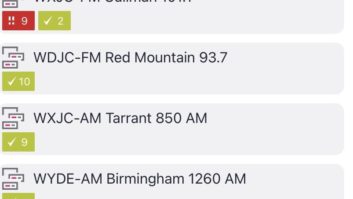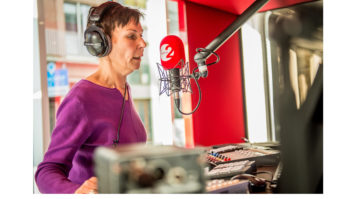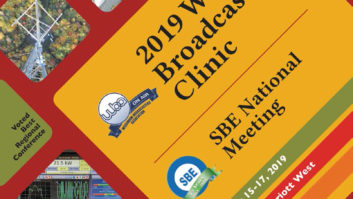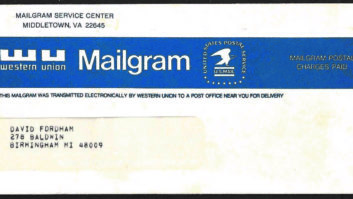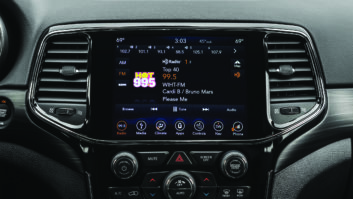One in a series of stories wrapping up activities at the spring NAB Show.

Executive committee members of the Association of Public Radio Engineers attending the PREC were, from left, Paxton Durham, David Antoine, Jobie Sprinkle, Ralph Hogan, Dan Mansergh, Rich Parker and Shane Toven.
Credit: Photos by Jim Peck The Public Radio Engineering Conference is geared toward practical information attendees can use right away. It’s planned by members of the Association of Public Radio Engineers and intended their peers, though some of what’s discussed applies to commercial stations as well.
Some 65 public radio engineers attended this year’s conference at Planet Hollywood in Las Vegas just prior to the spring NAB Show. Among highlights of the 13th annual event:
MANSERGH: FORM METADATA DISTRIBUTION STRATEGY
Consumers expect to see information about the programs they’re listening to displayed on receivers, said KQED’s Dan Mansergh.
He discussed the guideline for a standardized XML-based metadata distribution passed by the National Radio Systems Committee. Mansergh chairs the NRSC RBDS Subcommittee that adopted the document.
The point of the G301 guideline is to ensure consistent metadata distribution, all the way from producers to networks to stations. The guideline includes case studies that station engineers can use as examples, he said.
What next?
“As customers of network programs, ask producers to distribute program-associated data. As customers of automation systems, ask for G301 support,” he said. Mansergh urged stations to develop a PAD strategy for RDS and HD Radio displays, as well as displays for music players and Internet streams. The next step would be for vendors to automate portions of G301 into their systems, he added.
NPR LABS DEVELOPING TEXT-BASED ALERTS FOR DEAF, HOH
Rich Rarey shed some light on NPR Labs’ accessible radio project for the deaf and hard of hearing. Rarey is manager of Strategic Technology Applications at the Labs.
NPR Labs was awarded a contract from the Department of Homeland Security and the Federal Emergency Management Agency to create and demonstrate end-to-end text-based FM RDS alerts to the Gulf Coast states. The area was chosen because it’s hurricane-prone.
NPR Labs is working with DHS and FEMA to choose 25 public radio stations in Alabama, Florida, Louisiana, Mississippi and Texas to participate.
Specifically, FEMA will originate the CAP EAS alerts using its IPAWS system and transmit those alerts to the Public Radio Satellite System. The PRSS will retransmit the alerts using RDS to the 25 public stations on a dedicated warning channel. The stations will broadcast the alerts to receivers that can display the text messages.
The idea is to program the receiver to recognize the alert and prompt the radio to activate a bed shaker and a bright, flashing light.
“Today, people expect to see addressable products,” Rarey said, saying participants are discussing various ways to program the radio “to know where it is” in order to deliver the correct alert.
NPR Labs has developed a prototype receiver for the project.
The endeavor, which got underway in January, is expected to take about 12 months. At the project’s conclusion, it would be evaluated for possible rollout to the rest of the country, said Rarey.
LESSONS LEARNED IN SANDY
WBGO(FM) got through Superstorm Sandy “by asking a lot of questions and planning,” said David Antoine, chief engineer for the jazz-formatted station in Newark, N.J.
A big question the staff faced was how long they could operate in emergency mode. Antoine finds many radio managers only plan to operate in an emergency mode for a few hours.
Sandy was different; the station needed a plan for much longer. For example, the station put staff up in a hotel, but then the power there went out. “We had to think about how to get them out,” he said.
WBGO also now is sure to have an emergency kit on hand. “It sits on a shelf. It has mics, cables, etc.,” Antoine said. “We don’t pilfer from it. It’s ready to go in an emergency.” The station also has rechargeable flashlights plugged into studio power outlets and a hand-cranked radio at the ready.
LECLAIR HONORED
The Association of Public Radio Engineers honored Michael LeClair. The chief engineer of WBUR(FM) in Boston CE was nominated by his peers to receive the Seventh Annual APRE Engineering Achievement Award. He also is technical editor of RW Engineering Extra

The Association of Public Radio Engineers honored Michael LeClair. The chief engineer of WBUR(FM) in Boston was nominated by his peers to receive the Seventh Annual APRE Engineering Achievement Award. He also is technical editor of RW Engineering Extra. The honor is awarded to a single individual for “outstanding contributions” to the art and/or science of radio engineering that have made a “significant impact on, or improvement in” the state of the public radio industry.
Last year’s recipient was Mike Starling, vice president, Technology Research Center & NPR Labs. V-Soft Communications President Doug Vernier was honored in 2011.
LeClair has worked at WBUR 27 years. Prior to that, he was technical director at Trinity College-owned WRTC(FM), Hartford, Conn., while attending the school, and then for about five years after that before moving to Boston. The chief engineer at WBUR at the time, Jim Bonney, mentored LeClair.
In his acceptance remarks, LeClair recalled that an incident during which he tried to change a tube in the transmitter at WRTC “and the transmitter blew up,” taking the station off the air. LeClair put in another tube and the Collins transmitter was “still dead.”
He called Bonney for help. His mentor came to the station and trouble-shot the problem, using parts he’d stored. He fixed the transmitter and restored WRTC to air.
“I knew I wanted to be that guy. That was the moment I decided to become a radio engineer,” LeClair said.
Mentoring is important to the radio industry, LeClair said. “Mentoring is taking someone under your wing and helping them. Mentoring is unpaid. It’s saying to someone ‘You can do more and I can help you.’” The association noted LeClair’s role in helping educate fellow engineers through his work in editing Radio World Engineering Extra.
The award was presented at the annual APRE Engineering Awards Dinner.
NEW OFFICERS FOR 2013–14
The all-volunteer APRE has a new slate of officers for 2013–14.
Paxton Durham, chief engineer WVTF(FM), Roanoke, Va., is now APRE president. Dan Mansergh, KQED(FM) San Francisco director of radio engineering and media technology, becomes past president.
Jobie Sprinkle, director of Engineering/IT at WFAE(FM), Charlotte, N.C., is APRE vice president. Wyoming Public Media DOE Shane Toven is treasurer and Vermont Public Radio DOE Rich Parker becomes secretary.
Other board members are WWNO(FM), New Orleans Chief Engineer Robert Carroll; KBIA(FM), Columbia, Mo. Assistant Manager Roger Karwoski; and NPR Distribution Senior Solutions Architect Bruce Wahl.
Founding APRE President Ralph Hogan remains on the board. Hogan is associate general manager of Engineering & Technology Services for the Rio Salado College Division of Public Service in Phoenix, Ariz. The college oversees Phoenix FM stations KJZZ and KBAQ.
At the APRE meeting, the board unanimously approved additional association members to join them for a three-year term: David Antoine, chief engineer for WBGO(FM), Newark, N.J., and Dan Houg, engineer for KAXE(FM) Grand Rapids, Minn.
Two members are coming off the board: V-Soft Communications President Doug Vernier and Professional Audio Services Owner Gordon Carter.






